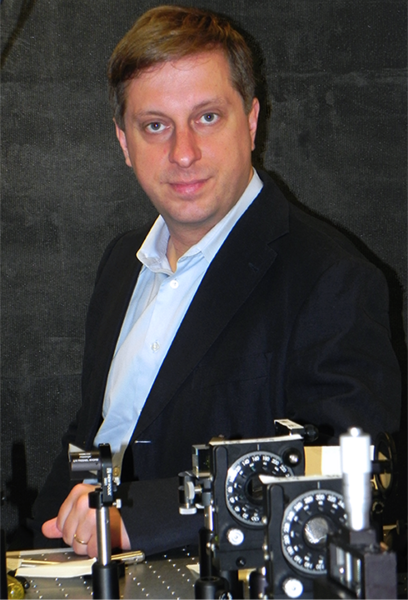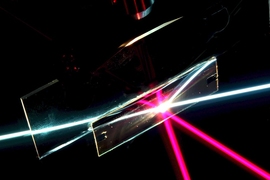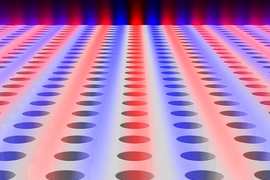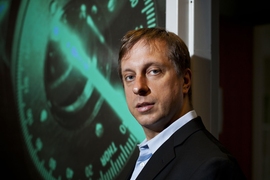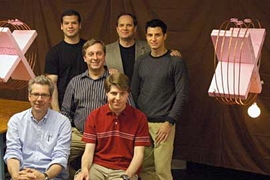Three fundamental properties are sufficient to describe any beam of light: its wavelength, its polarization, and its angle of travel. Filters to alter color and polarization are common, such as sunglasses and photographic filters. But the ability to filter light by angle remained elusive — until recent demonstrations by MIT physics professor Marin Soljacic and his Photonics and Modern Electro-Magnetics Group at MIT proved this was possible.
"If we did have such a thing ... I would expect that it would enable some new properties, some new applications, because it's so fundamental and important," Soljacic says. "You are controlling a very fundamental property of light."
Soljacic's graduate student Yichen Shen was lead author of a March 28 Science article, "Optical Broadband Angular Selectivity," describing the behavior of a sample stack of about 100 photonic crystal layers with alternating dielectric constants. The stack acts as a mirror at most angles, but becomes transparent at its so-called Brewster angle.
At the Brewster angle, which was 55 degrees in the experiment, 97 percent of light (specifically, p-polarized light) is transmitted across the sample, making it appear transparent. "At any other angle, light is nearly perfectly reflected," Soljacic says.
One potential use for this technology is privacy screens, which could be computer or cell phone screens visible only from one angle. (The new technique contrasts with privacy screens based on light absorption.)
Using angular selectivity has another advantage. At the angle of transmission, the full spectrum of visible light passes through, rendering full-color imaging. Other potential applications range from detectors to windshields. Our eyes, cell phones, cameras, radars, and telescopes are all examples of detectors. "In all of those systems, I'm trying to get light from one particular direction, while everything coming from the side presents a noise. And the thing about every single detector is what you care about is the signal-to-noise ratio. So notice, that if I can eliminate this noise, then it could potentially improve my signal-to-noise ratio and thereby potentially be useful for implementation of better detectors," Soljacic explains.
Solar energy motivation
"We were originally motivated for this by energy applications," Soljacic explains. The idea was to create a filter for solar thermal energy conversion systems that recaptured energy losses as the system heats up. The research was done in collaboration with the Solid State Solar Thermal Energy Conversion Center, directed by MIT mechanical engineering professor and department head Gang Chen and funded by the U.S. Departmet of Energy.
A solar thermal energy system is designed to absorb sunlight and convert it to electricity, but when the system heats up, it starts emitting light, which causes energy losses. "Very little light goes straight back towards the sun, so imagine if I had a materials system here that would let light through only if it comes exactly perpendicular, but any other light is reflected, then this light would be reflected back toward the system. I could recapture it and thereby this could go towards perfect solar radiation capture," Soljacic explains.
In a 2011 Nanoscale Research Letters paper, Soljacic and colleagues predicted theoretically that photonic crystals limiting radiation loss by angle and wavelength could boost thermal transfer efficiency to 78 percent, far in excess of the 31 percent Shockley-Quiesser efficiency limit for solar conversion without concentration. "Our theoretical prediction was if you did this really well, you wouldn't need solar concentration for such systems," Soljacic says. "However, we did not have such systems at the time; the one we just published this year presents a major step in that direction."
Deep understanding of physics
Among Soljacic group's recent research projects were creating a transparent display and demonstrating that light can be trapped on the surface of a photonic crystal. Like the angular selectivity demonstration, the projects, both led by Harvard University graduate student Chia Wei (Wade) Hsu, share a deep understanding of physics. "We investigate electromagnetic phenomena in general," Soljacic explains. His work runs the gamut of wavelengths, from megahertz frequencies to gamma rays. "You have the same equations describing it, so you see the same physics. Of course, the materials are very different, but the physics is the same," he says.
Soljacic focuses particularly on nonlinear optics and nanophotonics. "The interesting thing for us is that in nanophotonics, we create these artificially created materials which are structured at lengths substantially smaller than the wavelength of light," he explains.
A 3-D, periodic photonic crystal structure composed of two transparent materials, each with a different refractive index, can scatter light very strongly. "For some materials, if you do things right, you can open this thing called a complete photonic bandgap," Soljacic says. The bandgap represents light frequencies that are blocked from transmission while light above and below the bandgap is allowed to pass through. "For these frequencies the material looks like a perfect mirror," he says. "This bears a close resemblance for light as to what semiconductors present for electrons. Because of this, photonic crystals are sometimes called semiconductors for photons, and because semiconductors allow integration of electronics, in the same way, people believe that photonic crystals are one of the more interesting candidates to enable eventual integration of photonic devices." Those photonic devices would steer the flow of light on a chip in the same way semiconductors route the flow of electrons.
While one-dimensional photonic crystals have been known since 1887, and multi-dimensional photonic crystals since 1987, nature has evolved one-to-three-dimensional crystal structures over millions of years for producing color and camouflage. These structures account for the ability of an underwater worm called the sea mouse to reflect light in the absence of silver or other metals; the iridescent blue color of the Morpho butterfly; and the brown color in peacocks. The latter two are achieved without using pigments. Pigment loses color over time, but structural color can last much, much longer. Because the color depends on the particular structure of these crystals, stretching or squeezing them may change the color they produce.
Transparent displays
Transparent displays are of interest for cars or airplanes, so the driver or pilot doesn't have to look down. Typical transparent displays use a projector on the bottom and have low efficiency and a narrow angle of view. "That's fine when you're driving a car, because you don't move your head that much ... but if you want to have a broad viewing angle, then it's not so desirable," Soljacic explains.
Hsu led the demonstration of a blue transparent display composed of a clear polymer coating with embedded silver nanoparticles. (Hsu originally modeled resonant nanoparticles composed of a silica core and silver shell with a diameter of about 62 nanometers; polymer coating thickness was about half a millimeter.)
The researchers used an inexpensive laser projector to show the transparent display. "If you project just on regular glass, you don't see anything; if you project it on our screen, you can see projection," Soljacic says. Objects behind the glass are clearly visible.
Inspiration for the transparent display came to Soljacic while thinking about projects during a summer walk in the water at the beach. "Somehow it occurred to me that this could be one of the things that we could do, and it worked out really well actually," Soljacic says. The results were published in a Nature article, "Transparent displays enabled by resonant nanoparticle scattering," in January.
Confining surface light
Devices such as lasers, solar cells, and optical waveguides all require confining light in some way, typically with mirrors. Mirrors come in many varieties, including metallic mirrors, photonic crystal mirrors, and total internal reflection mirrors. But they all operate on the same principle. "Light comes to a surface of a material, and the properties of this material are such that light does not have modes to which it can couple to on [the] other side. Because light has nothing to couple to on the other side, it is reflected. That's how every single mirror in this world operates," Soljacic explains.
However, MIT researchers last summer were able to demonstrate that a photonic crystal slab could serve not just as a mirror, but could also confine light in a new way — neither reflecting nor transmitting the light, but trapping it on the surface. Reported in a Nature Letter last summer, the collaborative work by Hsu and co-first author Bo Zhen, demonstrated that at a certain angle (35 degrees in the study), light stays bound to the surface, oscillating indefinitely.
In 1929, scientists John von Neumann and Eugene Wigner theoretically predicted a similar state, which is known as an embedded eigenstate, for electrons. "We call such states to have 'the infinite quality factor, Infinite Q,'" Soljacic explains. The trapped state is in contrast to what typically happens when light propagates on a surface of a photonic crystal, which is that light may resonate on the surface for a time but normally escapes or decays. A separate, theoretical paper in Light: Science and Application detailed the physical and mathematical analysis of an embedded eigenstate, also known as a "Bound State in the Continuum," light trapped on the surface of a two-dimensional photonic crystal.
"Basically when you have a 1-D periodic photonic crystal, it will have a resonance on it. This resonance will decay energy to the right and to the left," Soljacic says. But under just the right conditions, light waves of equal amplitude but opposite phase can cancel out each other, preventing their escape. "I just want to emphasize how different this is compared to traditional ways of trapping light. ... Light here very much has modes to which it can couple. The reason it doesn't couple to them is because it eliminates its own leakage. It's a very new mechanism of trapping or confining light and whenever you discover a new mechanism in physics, it often enables new applications. That's why we are excited about it," Soljacic explains. Possible applications include optical filters, chemical or biological sensors and organic LEDs. Collaborators included John Joannopoulo, a physics professor and principal investigator at the Research Laboratory of Electronics; associate professor of mathematics Steven Johnson; and graduate students Bo Zhen, Jeongwon Lee, and Song-Liang Chua.
Soljacic's earlier work includes a mechanism for wireless power transfer, called WiTricity, which could enable cordless recharging of cell phones and other electronic devices.
